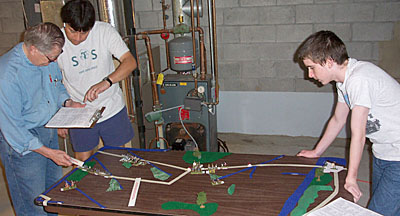
With every SN game, I try new ideas, and this was no exception. Since this was Russia, I upscaled the units from brigades to divisions (roughly 3000 infantry to the stand, 1500 cavalry, and 30-40 guns), and the ground scale to 1"=2.5 miles. Otherwise, trying to control close to a million troops by brigade from the Niemen River to Moscow would be so time consuming as to be worthless in terms of simulation. But there were other considerations.
Joe (left) marches northwards towards Riga prior to Napoleon's entry. Russ (Umpire, center) points out the appropriate movement rate on the one-page chart. Michael awaits the fury of the French with his corp deployed at the crossroads in the village of Shavli.
Historically, the French force marched a lot through a week of horrible thunderstorms (mud) in late June and and then five weeks of the most intense heat that nature could throw at them. They didn't lose just a few troops due to straggling (and leaving garrisons or detachments), they lost hundreds of thousands. Russian attrition was just as bad. So, how to put that into Snappy Nappy terms?
The Russians were the easiest. Even though their losses were staggering too, they collected troops on their retreat to maintain their strength. So, the Russians would not have attrition, per se. They did start outnumbered, but did have many forces "on call" that would eventually work their way to the tables.
First thought was to force the French to make an "attrition roll" every turn for every unit that exceeded 6" of movement. Well, that time-consuming ploy would cause carpal tunnel syndrome in everyone's wrist, so that was out! Instead, I automatically adjusted their forces to 4,000 troops instead of 3,000 per stand--a 25% loss rate. In effect, I subtracted the attrition losses automatically from the start of the campaign. This penalized them a bit in the beginning, but would even out as the campaign continued. No die rolls. No French players carping about losing troops from attrition.
Normally, SN uses two stands per infantry unit. Previously, I sometimes added a third stand to unusually large brigades and gave the player the option to remove the third stand instead of reducing the Morale Status level. This allowed the player to trade troops for time. The advantage of a third stand lay primarily with melee strength--you have a larger unit with more troops to send into an attack or to defend.
This time, I went primarily with three-stand infantry units, with many four-stand infantry units. You still had the option for removing stands instead of morale checks. Normally, when you have four stands in a unit, you split the unit into two two-stand units. However, to keep the number of units low, I went with the four-stand units. This would have unintended consequences later on.
For the first time, I included supply rules designed to force the French army to mimic what Napoleon faced--maintain a line of communications and see to it that his army received enough supplies to carry on. Historically, Napoleon ordered the creation of a massive supply train that didn't exactly work as planned. I used a pair of wagons hauling barrels that could be dropped off to create a chain of depots. As long as the French were within a certain distance, they were in supply. If not, then they had to make a morale check to see if they would suffer attrition from lack of supplies.
The Russians would always considered to be in supply. They had created a series of variously sized depots (represented on table with haystacks, cauldrons, barrels, and urns). Since they fell back on them, I called the Russians always in supply if they could trace a road to the east, north, or south edge of the table.
I also increased movement from 12" to 18" in road march on primary roads. I made a new terrain category--secondary roads-- and pegged that at 12" rate. That would increase the mobility of units, although perhaps a little too fast, but was worth a try.
I added an "Opportunity Charge." Now, I had been set against that, but players complain about all sorts of real or imagined marches going past them, so I added a half-move charge. You needed to make a morale check in order to do so, and if you missedd, you'd lose a morale status level. I should change the nomenclature to "Reaction Charge" because at this scale it is less an opportunity than a intervention point.
Finally, I reduced the number of Morale Status levels from 7 to 6. This would cause units to disintegrate faster, injecting more to and fro into the battle. Note that in SN, you roll morale checks until you pass, so it is possible for a probability defying string of failed rolls to rout a unit out of the game in one fell swoop. It's happened before and will happen in this game, too. Remember, reserves are are good idea...
More Snappy Nappy: The Russian Conflagration of 1812
-
Snappy Nappy Campaign Introduction
SN Rules Experiments: Pushing the Envelope
Preliminaries, Set Up, and Preparation
French Situation and Introduction
Russian Situation and Introduction
Orders of Battle: French and Russian
Snappy Nappy Rules Conventions
The Game From the Umpire's Neutral Perspective
French and Russian Messages in Chronological Order
History: The 1812 Invasion of Russia in a Nutshell
Large Campaign Map (slow: 101K)
Jumbo Campaign Map (monstrously slow: 877K)
Napoleon's Memoirs
Back to War Lore: The List
Back to Master Magazine List
© Copyright 2004 by Coalition Web, Inc.
This article appears in MagWeb.com (Magazine Web) on the Internet World Wide Web.
Other articles from military history and related magazines are available at http://www.magweb.com